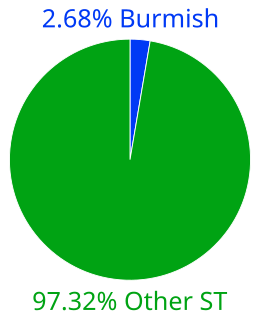| Kachin–Luic | |
|---|---|
| Jingpho–Luish | |
| Geographic distribution | India, Burma |
| Linguistic classification |
|
| Subdivisions | |
| Glottolog | jing1259 [1] |
The Kachin–Luic, Kachinic, Jingpho-Luish, or Jingpho-Asakian languages are a group of Sino-Tibetan languages belonging the Sal branch. They are spoken in eastern India and Burma, and consist of the Jingpho (also known as Kachin) language and the Luish (a.k.a. Asakian) languages Sak, Kadu, Ganan, Andro, Sengmai, and Chairel. Ethnologue and Glottolog include the extinct or nearly extinct Taman language in the Jingpo branch, but Huziwara (2016) [2] considers it to be unclassified within Tibeto-Burman.

The Sino-Tibetan languages, in a few sources also known as Trans-Himalayan, are a family of more than 400 languages, second only to Indo-European in number of native speakers. The Sino-Tibetan languages with the most native speakers are the varieties of Chinese, Burmese, and the Tibetic languages. Other languages of the family are spoken in the Himalayas, the Southeast Asian Massif and the eastern edge of the Tibetan Plateau. Most have small speech communities in remote mountain areas and as such are poorly documented. Unlike Western linguists, Chinese linguists generally include Kra–Dai and Hmong-Mien languages within Sino-Tibetan.
The Sal languages are a branch of Sino-Tibetan languages spoken in eastern India, parts of Bangladesh, and Burma
Jingpho or Kachin is a Tibeto-Burman language of the Sal branch mainly spoken in Kachin State, Burma and Yunnan, China. There are a lot of meanings for Jinghpo. In the Jinghpo language, Jinghpo means people. The term "Kachin language" can refer either to the Jingpho language or to a group of languages spoken by various ethnic groups in the same region as Jingpo: Lisu, Lashi, Rawang, Zaiwa, Lhao Vo, Achang and Jingpho. These languages are from distinct branches of the highest level of the Tibeto-Burman family. The Jingpho alphabet is based on the Latin script. Now, the Jinghpo language is also widely written in Burmese script.
Contents
James Matisoff (2013) [3] provides phonological and lexical evidence in support of the Jingpho-Asakian (Jingpho–Luish) grouping, dividing it into two subgroups, namely Jingphoic and Asakian . Proto-Luish has been reconstructed by Huziwara (2012) [4] and Matisoff (2013).
James Alan Matisoff is a professor emeritus of Linguistics at the University of California, Berkeley and noted authority on Tibeto-Burman languages and other languages of mainland Southeast Asia.
The Luish, Asakian, or Sak languages are a group of Sino-Tibetan languages belonging to the Sal branch. They are spoken in Burma and Bangladesh, and consist of the Sak, Kadu, and Ganan languages. In recent years, Luish languages have been influenced by Burmese and Chakma Bengali.
Jingpho-Luish languages contain many sesquisyllables. [3]


